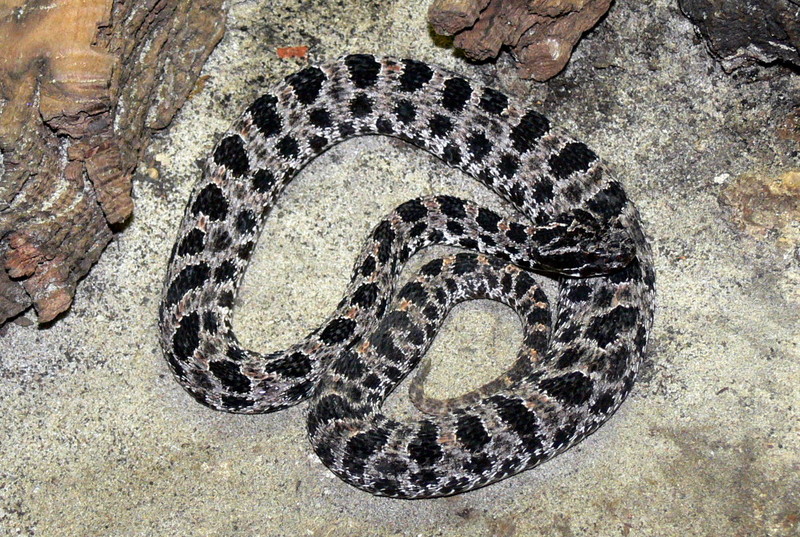|
| Query: pygmy hog | Result: 14th of 27 | |
Dusky Pigmy Rattlesnake (Sistrurus miliarius barbouri) - Wiki
| Subject: | Dusky Pigmy Rattlesnake (Sistrurus miliarius barbouri) - Wiki
| |

| Resolution: 1000x671
File Size: 407647 Bytes
Date: 2006:09:07 14:10:05
Camera: DMC-FZ30 (Panasonic)
F number: f/2.8
Exposure: 10/300 sec
Focal Length: 92/10
Upload Date: 2007:08:14 15:49:38
|
ERROR : Server Busy(-1105)
ERROR : Server Busy(-1105)
Dusky Pigmy Rattlesnake (Sistrurus miliarius barbouri) - Wiki
Sistrurus miliarius barbouri
From Wikipedia, the free encyclopedia
[Photo] Sistrurus miliaris barbouri. Date Sept. 2006. Author User:Haplochromis http://commons.wikimedia.org/wiki/User:Haplochromis
Common names: dusky pigmy rattlesnake, Florida ground rattlesnake, more.
Sistrurus miliarius barbouri is a venomous pit viper subspecies found in the southeastern United States.
Description
Adults grow to between 35.5 and 76 cm in length (Klauber, 1943). In a study that involved 103 males and 80 females, the average length was 53.5 cm. Snellings and Collins (1997) reported a specimen measuring 80.3 cm, but it had been in captivity for over 12 years. The largest reported by Gloyd (1940) was one measuring 63.8 cm from St. Petersburg, Florida.
Regarding the coloration, this subspecies has dorsal spots that are more rounded, usually has a whitish that is heavily flecked or mottled with black or dark brown, and generally has 23 rows of dorsal scales at midbody.
Common names
Florida ground rattlesnake, southeastern ground rattlesnake, pigmy rattlesnake, Barbour's pigmy rattlesnake, dusky pigmy rattlesnake, ground rattlesnake, hog-nosed rattler, pigmy ground rattlesnake, pigmy rattler, small rattlesnake.
Geographic range
Found in the United States from extreme southern South Carolina through southern Georgia, all of Florida, west through southern Alabama and southeastern Mississippi. The type locality listed is "Royal Palm Hammock, 12 miles west of Homestead, Dade County, Florida" (USA).
Reproduction
Gives birth to between 5 and 7 young at a time. In a brood of 8 from Silver Springs, Marion County, Florida, the neonates measured between 157 and 173 mm in total length.
Venom
Wright and Wright (1957) include excerpts from Allen (1938) that describes how an assistant was bitten in the Everglades and suffered severe pain and swelling for about 24 hours despite treatment. Allen also quotes some statistics: according to the Florida Reptile Institute, 28 people were bitten by this subspecies in Florida between 1935 and 1937 with no deaths.
Brown (1973) gives an average venom yield of 18 mg (dried venom) (Klauber, 1956) and LD50 values of 2.8,12.6 mg/kg IV, 6.0,6.8 mg/kg IP and 24.2 mg/kg SC for toxicity.
Whilst the venom of the snake contains disintegrins it has a KGD amino acid motif rather than the more common RGD motif. This single amino acid alteration gives the venom higher binding affinity for the fibrinogen receptor.
http://en.wikipedia.org/wiki/Sistrurus_miliarius_barbouri
| The text in this page is based on the copyrighted Wikipedia article shown in above URL. It is used under the GNU Free Documentation License. You may redistribute it, verbatim or modified, providing that you comply with the terms of the GFDL. |
|
Comments |
|---|
| | D. Kennedy |
|
| My 8 yr old son almost caught a small snake in our driveway, but I saw him in time to stop him. The snake was grey with black rectangular patterns going down it's back. This looked to be a younk snake. Can you identify it from this description? Thank you |
^o^
Animal Pictures Archive for smart phones
^o^
|
|
|

